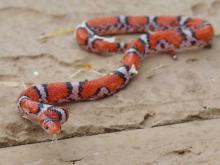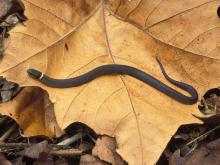Reptiles and Amphibians
Media

Species Types
Scientific Name
Thamnophis proximus proximus
Description
The orange-striped ribbonsnake is a type of gartersnake named for the attractive orange or yellow stripes running the length of its body, alternating with wide black stripes. It is found statewide, but seldom far from water.
Media

Species Types
Scientific Name
Cemophora coccinea copei
Description
One of Missouri's most brilliantly colored snakes is also extremely rare to find. The northern scarletsnake is similar in pattern and color to the more common red milksnake but has a red or orange snout and a spotless, white belly.
Media

Species Types
Scientific Name
Terrapene carolina triunguis
Description
The three-toed box turtle usually has three hind toes. Its high-domed shell usually has a top ridge and is olive or brown with faint yellow or orange lines. Look for it in woodland habitats.
Media

Species Types
Scientific Name
Acris blanchardi (formerly Acris crepitans blanchardi)
Description
Blanchard's cricket frog is a nonclimbing member of the treefrog family. It lacks the adhesive toe pads associated with treefrogs. It occurs statewide. The call is a metallic “gick, gick, gick.”
Media

Species Types
Scientific Name
Thamnophis sirtalis sirtalis (eastern gartersnake) and T. s. parietalis (red-sided gartersnake)
Description
The eastern gartersnake and red-sided gartersnake are Missouri's most common gartersnakes. The color is variable, but there are normally three yellowish stripes, one down the back and one on each side. There are narrow black bars between the scales along the upper lip.
Media

Species Types
Scientific Name
Diadophis punctatus arnyi
Description
Prairie ring-necked snakes are easily recognizable by their small size, uniform dark color on the back, bright yellow-orange belly, and distinct yellow ring around the neck. Secretive, but common nearly statewide.
Media

Species Types
Scientific Name
Notophthalmus viridescens louisianensis
Description
A small, olive-brown salamander with a fascinating life cycle, the central newt lives in and around woodland ponds and swamps in all but our far northwestern counties.
Media

Species Types
Scientific Name
Plethodon angusticlavius
Description
The Ozark zigzag salamander is small and slender, with a narrow, somewhat lobed back stripe that can be yellow, orange, or red. This woodland species lives in Missouri’s southwestern counties along the Arkansas border.
Media

Species Types
Scientific Name
Eurycea lucifuga
Description
The cave salamander is a common amphibian of the Ozark Plateau. It lives in caves, springs, and rocky streams. Recognize it by its normally bright orange skin dotted with dark brown or black spots.
Media

Species Types
Scientific Name
Ambystoma maculatum
Description
The spotted salamander is one of Missouri's six species of mole salamanders. It is slate black with two irregular rows of rounded yellow spots from the head onto the tail. It occurs in forests in the southern two-thirds of the state.
See Also
About Reptiles and Amphibians in Missouri
Missouri’s herptiles comprise 43 amphibians and 75 reptiles. Amphibians, including salamanders, toads, and frogs, are vertebrate animals that spend at least part of their life cycle in water. They usually have moist skin, lack scales or claws, and are ectothermal (cold-blooded), so they do not produce their own body heat the way birds and mammals do. Reptiles, including turtles, lizards, and snakes, are also vertebrates, and most are ectothermal, but unlike amphibians, reptiles have dry skin with scales, the ones with legs have claws, and they do not have to live part of their lives in water.





















